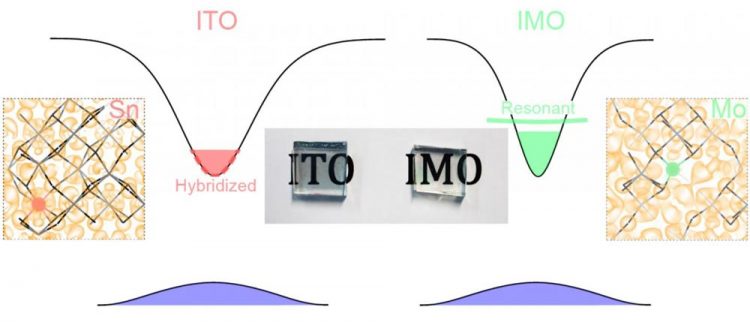Scientists' design discovery doubles conductivity of indium oxide transparent coatings

Superior transparent conducting properties of indium oxide realised by molybdenum donors resonant in the conduction band, avoiding detrimental effects of tin doping. Credit: University of Liverpool
Tin doped indium oxide -ITO – is the leading material used in the coating applied to the glass or clear plastic of touch screens, solar cells and light emitting diodes because it conducts electricity and allows light through.
ITO accounts for 60 per cent of the multibillion dollar transparent conducting oxide market and 60 per cent of global indium use. However, the search for materials that can replace ITO has increased significantly in recent years, as supplies of indium decrease and its price significantly increases.
Now, researchers have made an important design discovery that could see films and coatings which don't rely so heavily on this rare element.
In a paper published in Materials Horizons, scientists used a combination of experimental and theoretical approaches to explain how replacing tin with the transition metal molybdenum creates a vastly superior material – IMO – that has twice the conductivity of ITO. It can deliver better performance than ITO with only half the thickness and half the amount of indium.
PhD student Jack Swallow, from the University of Liverpool's Department of Physics and the Stephenson Institute for Renewable Energy, said: “This is an exciting new development in the field of transparent conductors and has the potential of extending the life of the world's indium supplies, which are in increasingly short supply.”
Professor David Scanlon of UCL said: “Our work illustrates the power of combining chemistry and physics experimental approaches with computational materials design.”
The researchers now intend to apply their new understanding to find alternative novel dopants to improve other transparent conductors.
This includes tin dioxide which contains only earth abundant elements and so is cheap enough for large area uses such as solar cells and energy efficient windows.
Liverpool Professor, Tim Veal, a co-author on the paper said: “Although IMO was first made several years ago, the reason why it is so much better than ITO wasn't understood.
“Our research finding represents a breakthrough and opens the way for industry to reduce its use of indium in displays and touch screens and provides a route for commercial development of better, cheaper transparent conductors for renewable energy applications.”
###
The paper “Resonant doping for high mobility transparent conductors: the case of Mo-doped In2O3” was published in Materials Horizons (DOI: 10.1039/c9mh01014a)
Media Contact
More Information:
http://dx.doi.org/10.1039/c9mh01014aAll latest news from the category: Materials Sciences
Materials management deals with the research, development, manufacturing and processing of raw and industrial materials. Key aspects here are biological and medical issues, which play an increasingly important role in this field.
innovations-report offers in-depth articles related to the development and application of materials and the structure and properties of new materials.
Newest articles

Photonic chip integrates sensing and computing for ultrafast machine vision
Technology eliminates optical-electronic conversions, holds promise for revolutionizing edge intelligence. Researchers have demonstrated a new intelligent photonic sensing-computing chip that can process, transmit and reconstruct images of a scene within…

Pair plasmas found in deep space can now be generated in the lab
An international team of scientists has developed a novel way to experimentally produce plasma ‘fireballs’ on Earth. Black holes and neutron stars are among the densest known objects in the…

New fabric makes urban heat islands more bearable
With applications in clothing, construction and food storage, the new textile reduces heat from both the sun and thermal radiation from nearby buildings. This year has already seen massive heatwaves…





















